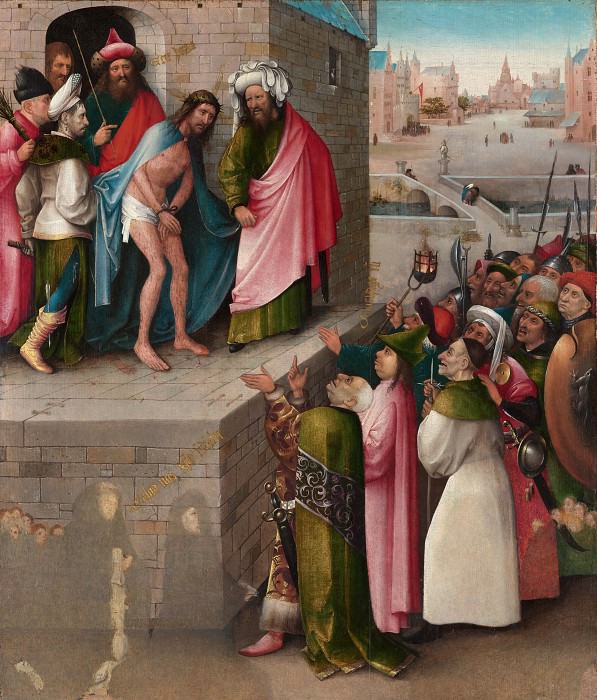Ecce Homo Hieronymus Bosch (1450-1516)
Hieronymus Bosch – Ecce Homo
Edit attribution
Download full size: 6961×8169 px (11,5 Mb)
Painter: Hieronymus Bosch
Location: Städelsches Kunstinstitut, Frankfurt am Main.
Hieronymus Bosch’s late 15th-century painting reveals a mise-en-scene of the encounter between Jesus Christ and Pontius Pilate in the face of a raging crowd. Jesus is portrayed exhausted and mutilated by the lashes, as well as with a crown of thorns on his head. Bosch imagined the crowd demanding the execution of the "false prophet" to represent one big multi-headed, evil and ugly monster with stupid faces and meaningless looks, looking also like an idle carnival crowd.
Description of Hieronymus Bosch’s painting Sé Man
Hieronymus Bosch’s late 15th-century painting reveals a mise-en-scene of the encounter between Jesus Christ and Pontius Pilate in the face of a raging crowd. Jesus is portrayed exhausted and mutilated by the lashes, as well as with a crown of thorns on his head.
Bosch imagined the crowd demanding the execution of the "false prophet" to represent one big multi-headed, evil and ugly monster with stupid faces and meaningless looks, looking also like an idle carnival crowd. It is for this purpose that the artist has dressed the people standing in bizarre and atypical for the time bright garments, among which are found ribbons, turbans and richly decorated cloaks.
These people are the manifestation and weapon of evil in the face of change, moving the world forward and pushing it on the path of truth.
In the distance, in the background, one can see the features of a Flemish town of those years, filled with towers, townspeople’s houses, and commercial buildings. The centerpiece of this perspective is the town hall in Northern Renaissance style.
The main message conveyed by the image of the city is a symbolic juxtaposition of injustice and bloodshed on the one hand and a quiet secular idyll on the other. The city sleeps, awakes and flourishes, while practically at its gates they put to death not just anyone, but the son of God himself.
Interestingly, on one of the balconies of an apartment building in the aforementioned city is a red flag with a crescent, a symbol of the infidels who betrayed Jesus Christ and who, in turn, are identified with the Islamic world, the then owner and invader of major Christian sanctuaries. The figure of an owl above the head of Pontius Pilate, as well as the toad on the shield of one of the guards, are clear heralds of impending grief and representations of the hopelessness of this world.
Another interesting point is connected with the lower left corner of the painting: after a closer look you can see some vague and hardly visible, as if deliberately erased, silhouettes of some people.
Nothing is known for certain, but speculation exists that these silhouettes belonged to donors (commissioners of works of art or architecture in the Catholic tradition) who for some reason were later erased from the canvas. The figures include a kneeling father, several children, and a Dominican monk, apparently crying out to God for the salvation of his own soul and the souls of the other innocents.
Кому понравилось
Пожалуйста, подождите
На эту операцию может потребоваться несколько секунд.
Информация появится в новом окне,
если открытие новых окон не запрещено в настройках вашего браузера.
You need to login
Для работы с коллекциями – пожалуйста, войдите в аккаунт (open in new window).




















You cannot comment Why?